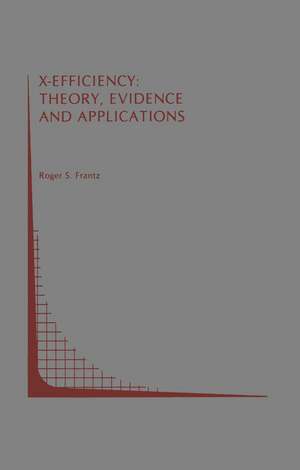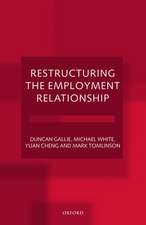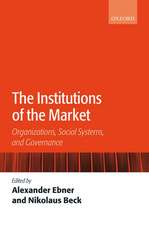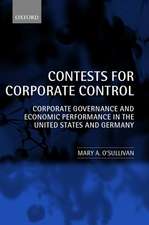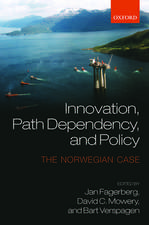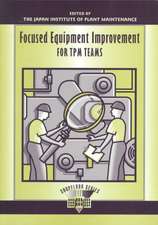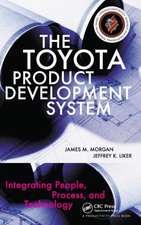X-Efficiency: Theory, Evidence and Applications: Topics in Regulatory Economics and Policy, cartea 2
Autor Roger S. Frantzen Limba Engleză Hardback – 31 ian 1988
| Toate formatele și edițiile | Preț | Express |
|---|---|---|
| Paperback (2) | 635.31 lei 6-8 săpt. | |
| Springer Us – 12 oct 2012 | 635.31 lei 6-8 săpt. | |
| Springer Us – 3 mar 2013 | 942.44 lei 6-8 săpt. | |
| Hardback (2) | 641.71 lei 6-8 săpt. | |
| Springer Us – 31 mai 1997 | 641.71 lei 6-8 săpt. | |
| Springer Us – 31 ian 1988 | 948.47 lei 6-8 săpt. |
Din seria Topics in Regulatory Economics and Policy
- 18%
 Preț: 893.71 lei
Preț: 893.71 lei - 18%
 Preț: 1108.67 lei
Preț: 1108.67 lei - 18%
 Preț: 899.06 lei
Preț: 899.06 lei - 24%
 Preț: 747.51 lei
Preț: 747.51 lei - 18%
 Preț: 1118.75 lei
Preț: 1118.75 lei - 15%
 Preț: 649.87 lei
Preț: 649.87 lei - 18%
 Preț: 1117.03 lei
Preț: 1117.03 lei - 15%
 Preț: 593.08 lei
Preț: 593.08 lei - 18%
 Preț: 789.98 lei
Preț: 789.98 lei - 18%
 Preț: 1233.20 lei
Preț: 1233.20 lei - 18%
 Preț: 944.99 lei
Preț: 944.99 lei - 15%
 Preț: 640.71 lei
Preț: 640.71 lei - 18%
 Preț: 953.35 lei
Preț: 953.35 lei - 18%
 Preț: 953.35 lei
Preț: 953.35 lei - 18%
 Preț: 954.45 lei
Preț: 954.45 lei -
 Preț: 385.47 lei
Preț: 385.47 lei - 15%
 Preț: 647.27 lei
Preț: 647.27 lei - 15%
 Preț: 639.90 lei
Preț: 639.90 lei - 15%
 Preț: 643.34 lei
Preț: 643.34 lei - 18%
 Preț: 951.14 lei
Preț: 951.14 lei - 15%
 Preț: 646.11 lei
Preț: 646.11 lei - 18%
 Preț: 1487.96 lei
Preț: 1487.96 lei - 15%
 Preț: 640.71 lei
Preț: 640.71 lei - 18%
 Preț: 950.03 lei
Preț: 950.03 lei - 15%
 Preț: 643.34 lei
Preț: 643.34 lei - 15%
 Preț: 647.40 lei
Preț: 647.40 lei
Preț: 948.47 lei
Preț vechi: 1156.67 lei
-18% Nou
Puncte Express: 1423
Preț estimativ în valută:
181.51€ • 188.80$ • 149.85£
181.51€ • 188.80$ • 149.85£
Carte tipărită la comandă
Livrare economică 14-28 aprilie
Preluare comenzi: 021 569.72.76
Specificații
ISBN-13: 9780898382426
ISBN-10: 0898382424
Pagini: 228
Ilustrații: XX, 228 p.
Dimensiuni: 155 x 235 x 16 mm
Greutate: 0.53 kg
Ediția:1987
Editura: Springer Us
Colecția Springer
Seria Topics in Regulatory Economics and Policy
Locul publicării:New York, NY, United States
ISBN-10: 0898382424
Pagini: 228
Ilustrații: XX, 228 p.
Dimensiuni: 155 x 235 x 16 mm
Greutate: 0.53 kg
Ediția:1987
Editura: Springer Us
Colecția Springer
Seria Topics in Regulatory Economics and Policy
Locul publicării:New York, NY, United States
Public țintă
ResearchCuprins
1. Introduction.- 1.1. Introduction.- 1.2. X- and allocative efficiency, and the welfare losses from monopoly power.- 1.3. X-efficiency, and the neoclassical production and cost functions.- 1.4. The development of XE theory.- 1.5. XE theory and generalized neoclassical theory..- 1.6. XE theory as a research design.- 1.7. Empirical research on XE theory.- 1.8. Critics of XE theory.- 2. Production, cost, and welfare: A review.- 2.1. Introduction.- 2.2. The firm in the short run.- 2.3. The firm in the long run.- 2.4. Firms, markets, and efficiency.- 2.5. Implications.- Appendix: Regulation theory and X-efficiency.- 3. X-efficiency: The intellectual setting and an introduction to the theory.- 3.1. Introduction.- 3.2. Complex objective functions.- 3.3. XE theory: An introduction.- 3.4. Conclusions.- 4. X-efficiency theory: 1.- 4.1. Introduction.- 4.2. The individual in XE theory.- 4.3. Individual effort and the inert area.- 4.4. Conclusions.- 5. X-efficiency theory: 2.- 5.1. Introduction.- 5.2. Intrafirm determinants of individual and group effort.- 5.3. Productivity, effort conventions, and the prisoner’s dilemma.- 5.4. Market structure, pressure, and effort.- 5.5. A synthesis and an illustration.- 5.6. Implications and conclusions.- Appendix: Regulation and X-efficiency.- 6. Empirical evidence: Regulated industries.- 6.1. Introduction.- 6.2. Electric Utilities.- 6.3. Local government services.- 6.4. Symphony orchestras.- 6.5. Airlines.- 6.6. Conclusions.- 7. Empirical evidence: Ownership form.- 7.1. Introduction.- 7.2. Owner- versus manager-controlled firms.- 7.3. Public versus private ownership.- 7.4. Conclusions.- 8. Empirical evidence: Market structure.- 8.1. Introduction.- 8.2. Output and input ratios.- 8.3. Profits and X-efficiency.- 8.4. Price-fixing behavior.-8.5. Conclusions.- 9. X-efficiency, its critics, and a reply.- 9.1. Introduction.- 9.2. Rent-seeking.- 9.3. Leisure as output.- 9.4. Management utility under competition.- 9.5. Property rights.- 9.6. Some general comments.- 10. Implications and conclusions.- 10.1. X- and Allocative Efficiency.- 10.2. X-efficiency theory as a research design.- 10.3. X-efficiency and its critics.- 10.4. X-efficiency theory and neoclassical theory: Some final thoughts.- References.
Recenzii
`The major contribution, in my opinion, is that it provides a rich resource for the use of any scholar who wishes to learn about the x-efficiency theory and its existence in the real world. Moreover, it willprovide very valuable assistance to any researcher in any field who is studying questions of efficiency, worker motivation, and the psychology of the work place.'
Journal of Economic Behavior and Organization, 14, 1990.
Journal of Economic Behavior and Organization, 14, 1990.
